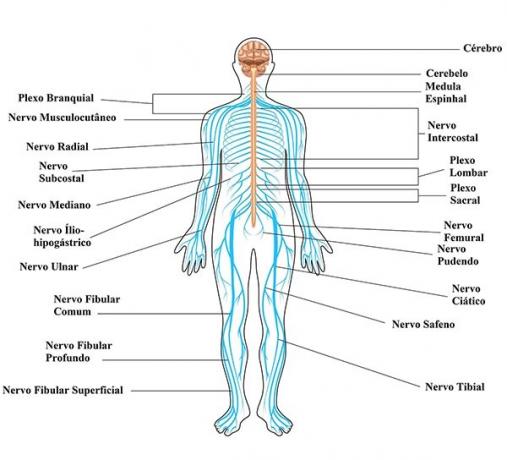Nervous system is the set formed by connections of nerves and organs of the body, with the function of capturing information, messages and other external stimuli, as well as responding to them, in addition to to be responsible for commanding the execution of all body movements, whether voluntary or involuntary.
Between the main functions of the nervous system it is the control and command of all other physiological systems in the body, such as the respiratory, cardiac, digestive, etc.
Thanks to the nervous system people are able to identify, interpret and "store" all stimuli external (smells, tastes, sounds, touches, images, etc.) and internal (feeling of hunger, for example) they receive.
Nervous system anatomy

You neurons they are the functional cells of the nervous system, that is, they are responsible for the exchange of nerve impulses (synapses) that transmit information from peripheral areas of the body to the central nervous system and vice versa.
The nervous system of human beings is divided into two main parts: central and peripheral.
central nervous system (CNS)
It consists of two main parts: o brain and the spinal cord. The brain, in turn, consists of the junction of three essential organs: the brain, the cerebellum and the brainstem.
O brain it is the most important and complex organ of the nervous system, responsible mainly for thoughts, memories and other functions related to human senses and cognition.
O cerebellum, which is located below the brain, has the main function of maintaining the body's balance and regulating muscle tone.
already the brain stem it functions as the "transport medium" of nerve impulses from the brain to the spinal cord and vice versa. In addition, it is also responsible for all involuntary movements of vital activities, such as heartbeat, breathing movements and reflexes, such as coughing and sneezing, for example.
THE spinal cord it is located inside the spine, with the main function of transporting nerve impulses to all parts of the body towards the brain.
Learn more about Muscle tone.
Peripheral Nervous System (PNS)
It is basically made up of nerves that connect the rest of the body to the central nervous system, through the brain and spinal cord. There are two main types of classes of nerves in this nervous system: the cranials and the spinal.
The cranial nerves have the main task of transmitting motor and sensory messages to the head and neck regions. The spinal nerves, on the other hand, are made up of sensory neurons and they are present in all parts of the body, capturing external impulses and transporting them to the system central nervous system.
The peripheral nervous system can be further divided into: somatic nervous system and autonomic nervous system.
The distinction between the two is simple: the somatic system regulates voluntary actions, that is, those that people are able to control. The autonomic nervous system deals with involuntary actions and acts in an integrated way with the central nervous system. It also has two subdivisions: o sympathetic nervous system it's the parasympathetic nervous system.
The sympathetic nervous system stimulates the functioning of organs, while the parasympathetic nervous system inhibits the functioning of these organs. Both systems have completely opposite functions.
Example: the sympathetic nervous system inhibits salivation, speeds up the heartbeat and promotes ejaculation, while the parasympathetic nervous system stimulates salivation, reduces heart rate and promotes erection.
Nervous System Diseases
Some of the diseases that can affect the nervous system and seriously impair its functioning are: cerebrovascular accident (CVA), epilepsy, multiple sclerosis, Alzheimer's, Huntington's disease, among others.
Learn more about the meaning of Parts of the human body.
